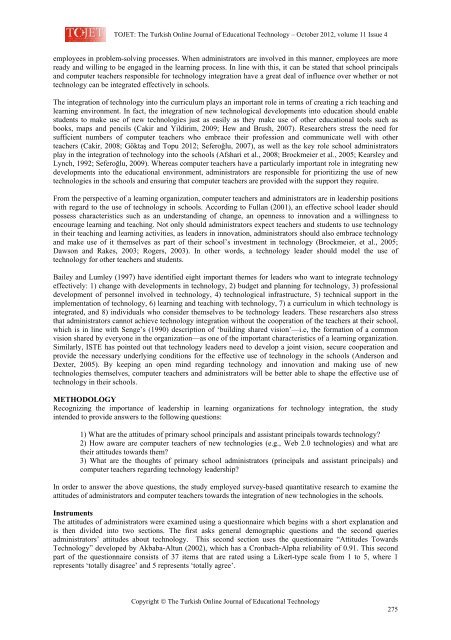october 2012 - TOJET the Turkish online journal of educational ...
october 2012 - TOJET the Turkish online journal of educational ...
october 2012 - TOJET the Turkish online journal of educational ...
You also want an ePaper? Increase the reach of your titles
YUMPU automatically turns print PDFs into web optimized ePapers that Google loves.
<strong>TOJET</strong>: The <strong>Turkish</strong> Online Journal <strong>of</strong> Educational Technology – October <strong>2012</strong>, volume 11 Issue 4<br />
employees in problem-solving processes. When administrators are involved in this manner, employees are more<br />
ready and willing to be engaged in <strong>the</strong> learning process. In line with this, it can be stated that school principals<br />
and computer teachers responsible for technology integration have a great deal <strong>of</strong> influence over whe<strong>the</strong>r or not<br />
technology can be integrated effectively in schools.<br />
The integration <strong>of</strong> technology into <strong>the</strong> curriculum plays an important role in terms <strong>of</strong> creating a rich teaching and<br />
learning environment. In fact, <strong>the</strong> integration <strong>of</strong> new technological developments into education should enable<br />
students to make use <strong>of</strong> new technologies just as easily as <strong>the</strong>y make use <strong>of</strong> o<strong>the</strong>r <strong>educational</strong> tools such as<br />
books, maps and pencils (Cakir and Yildirim, 2009; Hew and Brush, 2007). Researchers stress <strong>the</strong> need for<br />
sufficient numbers <strong>of</strong> computer teachers who embrace <strong>the</strong>ir pr<strong>of</strong>ession and communicate well with o<strong>the</strong>r<br />
teachers (Cakir, 2008; Göktaş and Topu <strong>2012</strong>; Seferoğlu, 2007), as well as <strong>the</strong> key role school administrators<br />
play in <strong>the</strong> integration <strong>of</strong> technology into <strong>the</strong> schools (Afshari et al., 2008; Brockmeier et al., 2005; Kearsley and<br />
Lynch, 1992; Seferoğlu, 2009). Whereas computer teachers have a particularly important role in integrating new<br />
developments into <strong>the</strong> <strong>educational</strong> environment, administrators are responsible for prioritizing <strong>the</strong> use <strong>of</strong> new<br />
technologies in <strong>the</strong> schools and ensuring that computer teachers are provided with <strong>the</strong> support <strong>the</strong>y require.<br />
From <strong>the</strong> perspective <strong>of</strong> a learning organization, computer teachers and administrators are in leadership positions<br />
with regard to <strong>the</strong> use <strong>of</strong> technology in schools. According to Fullan (2001), an effective school leader should<br />
possess characteristics such as an understanding <strong>of</strong> change, an openness to innovation and a willingness to<br />
encourage learning and teaching. Not only should administrators expect teachers and students to use technology<br />
in <strong>the</strong>ir teaching and learning activities, as leaders in innovation, administrators should also embrace technology<br />
and make use <strong>of</strong> it <strong>the</strong>mselves as part <strong>of</strong> <strong>the</strong>ir school’s investment in technology (Brockmeier, et al., 2005;<br />
Dawson and Rakes, 2003; Rogers, 2003). In o<strong>the</strong>r words, a technology leader should model <strong>the</strong> use <strong>of</strong><br />
technology for o<strong>the</strong>r teachers and students.<br />
Bailey and Lumley (1997) have identified eight important <strong>the</strong>mes for leaders who want to integrate technology<br />
effectively: 1) change with developments in technology, 2) budget and planning for technology, 3) pr<strong>of</strong>essional<br />
development <strong>of</strong> personnel involved in technology, 4) technological infrastructure, 5) technical support in <strong>the</strong><br />
implementation <strong>of</strong> technology, 6) learning and teaching with technology, 7) a curriculum in which technology is<br />
integrated, and 8) individuals who consider <strong>the</strong>mselves to be technology leaders. These researchers also stress<br />
that administrators cannot achieve technology integration without <strong>the</strong> cooperation <strong>of</strong> <strong>the</strong> teachers at <strong>the</strong>ir school,<br />
which is in line with Senge’s (1990) description <strong>of</strong> ‘building shared vision’—i.e, <strong>the</strong> formation <strong>of</strong> a common<br />
vision shared by everyone in <strong>the</strong> organization—as one <strong>of</strong> <strong>the</strong> important characteristics <strong>of</strong> a learning organization.<br />
Similarly, ISTE has pointed out that technology leaders need to develop a joint vision, secure cooperation and<br />
provide <strong>the</strong> necessary underlying conditions for <strong>the</strong> effective use <strong>of</strong> technology in <strong>the</strong> schools (Anderson and<br />
Dexter, 2005). By keeping an open mind regarding technology and innovation and making use <strong>of</strong> new<br />
technologies <strong>the</strong>mselves, computer teachers and administrators will be better able to shape <strong>the</strong> effective use <strong>of</strong><br />
technology in <strong>the</strong>ir schools.<br />
METHODOLOGY<br />
Recognizing <strong>the</strong> importance <strong>of</strong> leadership in learning organizations for technology integration, <strong>the</strong> study<br />
intended to provide answers to <strong>the</strong> following questions:<br />
1) What are <strong>the</strong> attitudes <strong>of</strong> primary school principals and assistant principals towards technology?<br />
2) How aware are computer teachers <strong>of</strong> new technologies (e.g., Web 2.0 technologies) and what are<br />
<strong>the</strong>ir attitudes towards <strong>the</strong>m?<br />
3) What are <strong>the</strong> thoughts <strong>of</strong> primary school administrators (principals and assistant principals) and<br />
computer teachers regarding technology leadership?<br />
In order to answer <strong>the</strong> above questions, <strong>the</strong> study employed survey-based quantitative research to examine <strong>the</strong><br />
attitudes <strong>of</strong> administrators and computer teachers towards <strong>the</strong> integration <strong>of</strong> new technologies in <strong>the</strong> schools.<br />
Instruments<br />
The attitudes <strong>of</strong> administrators were examined using a questionnaire which begins with a short explanation and<br />
is <strong>the</strong>n divided into two sections. The first asks general demographic questions and <strong>the</strong> second queries<br />
administrators’ attitudes about technology. This second section uses <strong>the</strong> questionnaire “Attitudes Towards<br />
Technology” developed by Akbaba-Altun (2002), which has a Cronbach-Alpha reliability <strong>of</strong> 0.91. This second<br />
part <strong>of</strong> <strong>the</strong> questionnaire consists <strong>of</strong> 37 items that are rated using a Likert-type scale from 1 to 5, where 1<br />
represents ‘totally disagree’ and 5 represents ‘totally agree’.<br />
Copyright © The <strong>Turkish</strong> Online Journal <strong>of</strong> Educational Technology<br />
275
















